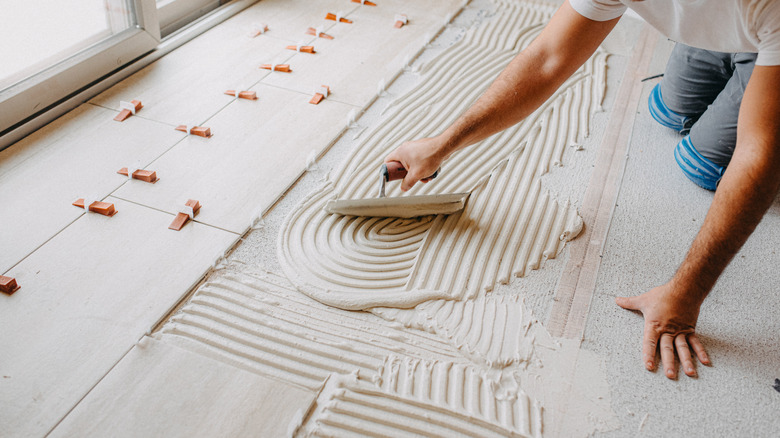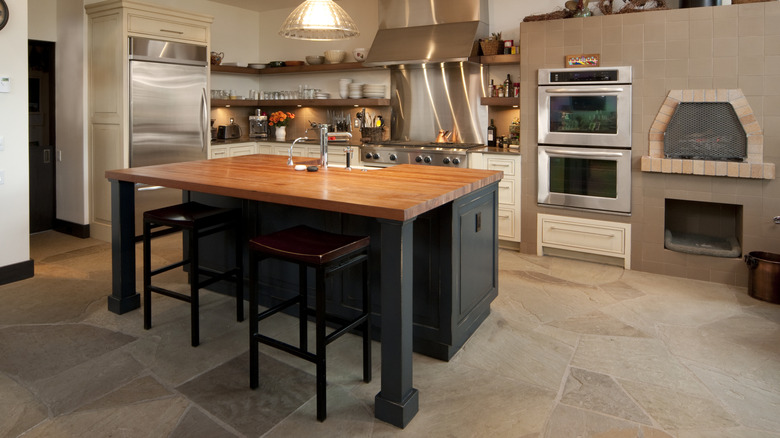The Durable Flooring HGTV's Mike Holmes Recommends For Kitchens (It's Not Hardwood)
Renovating your kitchen can be a huge undertaking, with so many more choices than you originally thought possible. There's of course the need to choose the perfect kitchen countertop color and material, and pick the best backsplash to pair with it. But one of the most important choices when it comes to having a durable kitchen lies beneath these other aesthetic points, all the way down to the floor. Choosing a material for your kitchen's flooring is a critical part of building the space, and experts have varying opinions. Mike Holmes, a Canadian homebuilder and the host of HGTV's show "Holmes on Homes" recommends ceramic and porcelain tiling for kitchen floors.
This advice counters what some popular trends are telling homeowners to select: namely, it's not hardwood. There are lots of reasons hardwood floors are the right choice for your home, mainly due to its timeless look, durability, and easy maintenance. However, it's best for areas like the living rooms and bedrooms. The benefits decrease when you think about installing it in a kitchen. "Wood is prone to moisture damage and can be marked and dented when you drop something," the housing expert wrote on his Make It Right blog.
Why tile is top notch
Durability and ease of installation are two major reasons why Holmes recommends ceramic and porcelain tiles for kitchen floors. Ceramic tiles specifically are stellar for high traffic parts of your home, and should last you for a minimum of 20 years. They also come in just about every size and color, including tile options that are made to look like marble or hardwood. So you can get the hardwood aesthetic you crave with a more kitchen-friendly material.
"Ceramic tile is made of natural clay-based products, minerals, and water," Holmes explained in his Make It Right Blog. This makes them eco-friendly, resilient, and cost effective — certain ceramic tiles can start at $0.50 per square foot. Holmes also said that they're also relatively easy to clean and maintain, so long as you have a perfect tile floor installation. To clean, you simply need to mop or wipe your ceramic floors, as the material won't absorb spills or stains. And, the tiles are perfect for kitchens that are close to the outdoor area in anyway (whether they're in your yard or next to a door that leads outside) because "tile can handle the moisture and dirt that is bound to come in," Holmes added.
Pros and cons of other flooring types
Beyond the ever-popular hardwood floors and the Holmes-backed ceramic or porcelain tiling, there are two other trendy types of floors that you can consider for your kitchen – natural stone and concrete. Natural stone is a particularly trendy selection because it looks, obviously, natural. Many homeowners enjoy the unique and nature-inspired textures and patterns offered by natural stone, and love its sustainability. However, this material will certainly be more costly than ceramic or porcelain tiling and is often harder to repair, due to its unique natural and fragile material.
Concrete floors are great for achieving an industrial look in a home, although it comes with plenty of other finishes. The material is incredibly durable and fire safe, and is also easy to maintain, only requiring debris and dirt removal as well as stain removal. However, some reasons against this flooring type include that it can crack if not installed properly. It's also much sleeker and more slippery, so concrete floors could pose a threat if you love walking around in socks. Holmes noted that he's also found that concrete is too heavy for some homes. There's a lot of joist strength required to uphold poured concrete, so this material is better for if you know your home has a very strong foundation.


